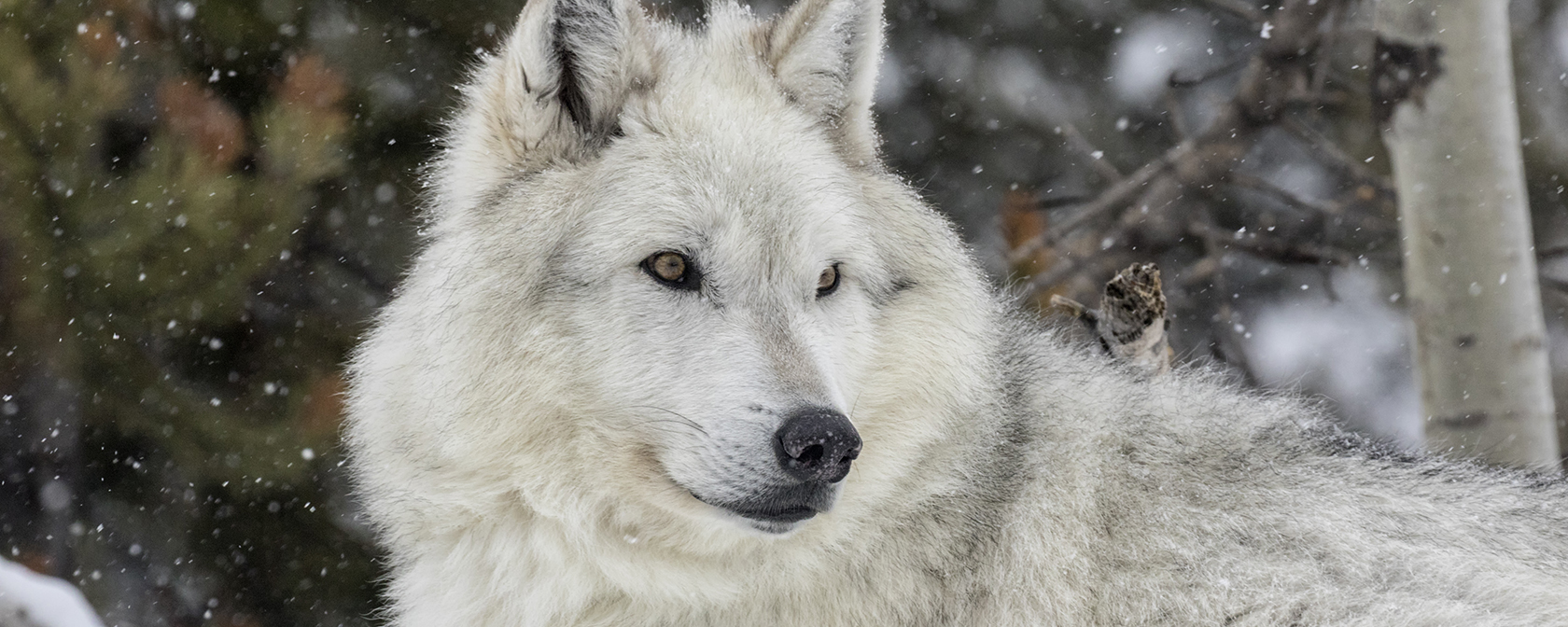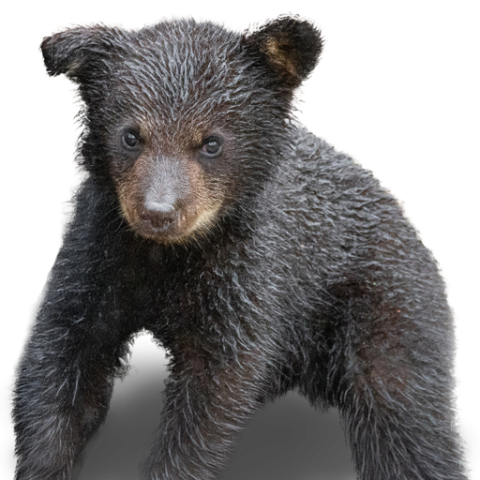By Amanda Wight
Wolves are one of the most vilified species in the world, and so our work to protect them has spanned decades and seen highs and lows. Recently, the European Union voted to downgrade the protection status of wolves, and in the U.S. there are new attempts to roll back wolf protections as well. Here, Amanda Wight, our senior program manager of wildlife protection at Humane World for Animals, tells the story of seeing wolves in the wild.
It was three years ago when I saw something I would never forget. My family had taken a quick day trip to Yellowstone National Park while visiting my sister in Montana. Soon after entering the Lamar Valley, we saw a group gathered with their long spotting scopes pointed up a hillside at a wolf den. When we aimed our binoculars in that direction, we still couldn’t quite see anything. But some people in the group graciously offered us their scopes to peek through. Even though we could just barely make out a few little balls of fluff in the hazy distance, I was hooked. It was the first time I saw wolves in the wild, and I knew it wouldn’t be the last.
Every day, I become even more fascinated by wolves; they are highly intelligent, social animals who are deeply devoted to their families, and yet in popular culture they are often antagonized, cast as evil, conniving and dangerous.
Tragically, outside of national parks like Yellowstone, human actions tear wolf families apart and are the primary cause of death for wild wolves. Hundreds of wolves are killed each year through recreational trophy hunting and trapping, poaching, and following conflicts with livestock. This relentless persecution isn’t new. In the 19th and early 20th centuries, humans led extermination campaigns against wolves in the U.S. and pushed them to the brink of extinction. They were listed under the Endangered Species Act to give them the chance to recover.
Today, we are facing one of the most serious threats to wolves that we’ve seen in the U.S. Just last month, a federal bill, the misleadingly named Pet and Livestock Protection Act (H.R. 845), passed out of the House Natural Resources Committee and the next step will be consideration by the full U.S. House of Representatives. The Senate counterpart of this bill, S.1306, was introduced as well. Far from protecting pets or farmed animals, this bill would take federal Endangered Species Act protections away from wolves and prohibit citizens and advocacy organizations from holding decisionmakers accountable to science and the law in court. In other words, if this bill passes, we’ll have no recourse, and many more wolves will be killed.
A question we frequently hear voiced by a small, but vocal faction of our society is, “How many wolves are enough?” While seemingly benign, this question is rooted in a misunderstanding of wolves and their essential role. There is a silent second half to this question; what they are really asking is, “How many wolves are enough for us to be able to kill some of them?” This treats wolves as a resource or crop, as evidenced by the common use of the euphemism “harvest” by people talking about trophy hunting and recreational trapping practices.
Some treat wolves exclusively as “problem” animals and try to justify killing campaigns. But conflicts between wolves and domestic animals are rare and best prevented through non-lethal measures. What’s more, wolves are extremely wary of humans and literally pose less of a danger to us than a vending machine. Most importantly, at the heart of our drive for change is that wolves are individuals who deserve our care and compassion. They are a part of our society, and their well-being matters.
The question should not be about whether we can artificially control population levels to an arbitrary numerical goal through killing or solve the perceived “problem” of wolves. The fact is that as an apex carnivore (which means being positioned at the top of the food chain), the species’ population is naturally controlled by prey and habitat availability and their social dynamics. Rather, it should be about how we can respect the well-being of wolves and their families while living alongside them, recognizing that they deserve care and protection from the harm that humans [or human activity] pose to them. The answer should be about supporting the recovery of a self-regulating, genetically diverse, socially intact population that maintains connectivity with wolf populations in neighboring areas and fulfills its ecological role.
Join us in taking action for wolves >>
At the same time, we are seeing similar threats to grizzly bears and the Endangered Species Act itself. It is essential that everyone who cares about animals contacts their federal lawmakers to urge them to uphold existing protections under the Endangered Species Act and oppose any efforts to take protections away from vulnerable native carnivores.
Our native carnivore protection team has always advocated passionately for animals who have been unfairly vilified by society, and this is especially true for wolves. We revel in taking deep dives into the latest scientific literature, and our message threads feature countless videos and articles about the lives of wolves and the people and organizations working to promote coexistence with them.
One day of wolf-watching in Yellowstone was never going to be enough for me. I’ve returned to the park three times since then, both personally and professionally, with members of our Humane World for Animals Wildlife Protection team. In fall 2022, a few of us took a wolf-focused tour at Yellowstone. This was just a few months after a historic flooding event devastated the park, and at the time, only approved commercial tours were allowed to enter from the north side during certain time windows. Together, we watched Wolf 1048M rest after eating a meal and slowly make his way across the landscape while calling for pups so he could feed them. As we watched, we relished in author, wolf-watcher and former National Park Service ranger Rick McIntyre’s tales of this wolf’s life, describing him as the “nicest wolf in the park,” thanks to his reputation for defending and providing for members of his pack. I was awed by the resilience of this wolf and his family in light of the flooding. Earlier this year, Wolf 1048M passed away at the age of 10, an incredible life span for a wild wolf.
Of course, while wolves in Yellowstone National Park are perhaps the most visible to the general public, the park is not the only place wolves live. I have spent days delighting in tracks, scat and bits of fur in the Great Lakes region and the Pacific Northwest. I remember the sly chuckle of a wolf biologist as I excitedly snapped photos of the single wolf hair we found snagged on a fence post and took joy in the fact that a nearby trail camera confirmed a wolf had visited that same location just hours earlier. We were walking where wolves had walked! These experiences just reaffirmed what I already knew: Rather than being dangerous and aggressive, as some people think of them, wolves are incredibly shy—even wolf biologists rarely see them in the field.
As animal welfare advocates, we fight for individual wolves, their family packs and their population. The most powerful tool we have for this work is policy reform, and that’s what our team does best. As we fight for wolves in Congress, the courts and state legislative and regulatory bodies, it’s critical that we carry their stories with us. Such stories dispel myths and promote both compassion for and passion for the protection of our native wildlife.
Join us in taking action for wolves.
Amanda Wight is senior program manager of wildlife protection for Humane World for Animals.




